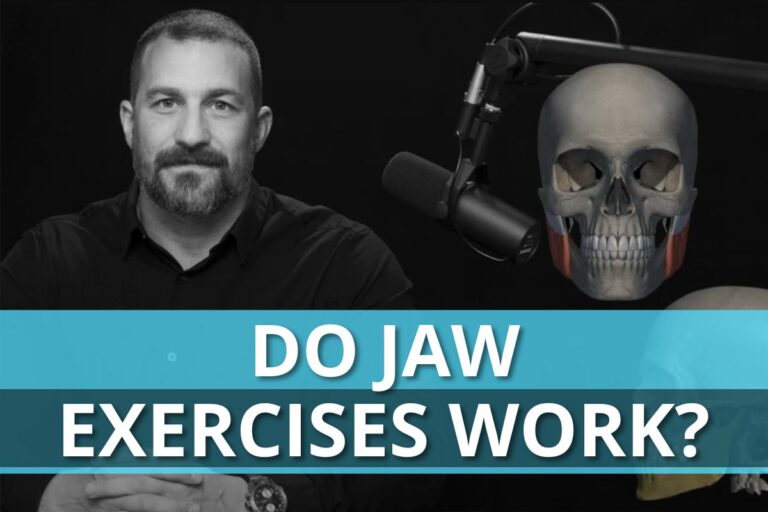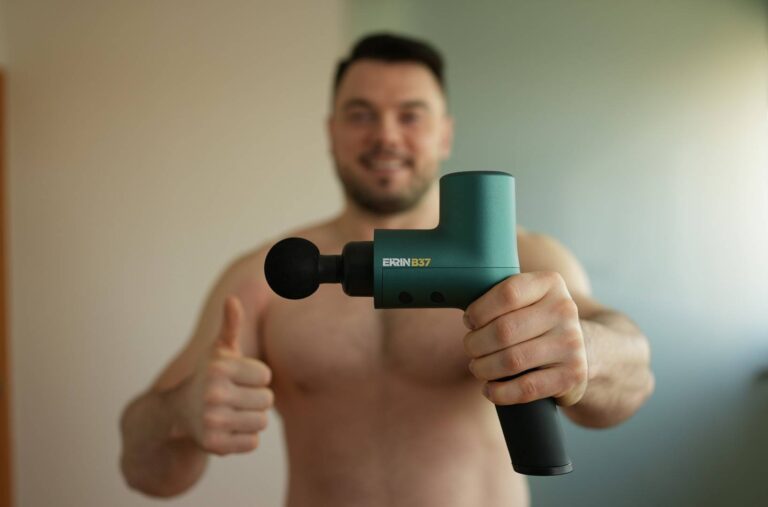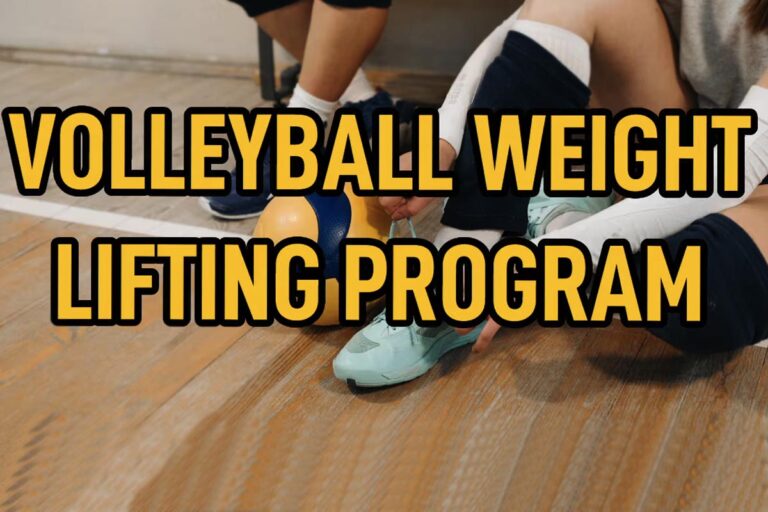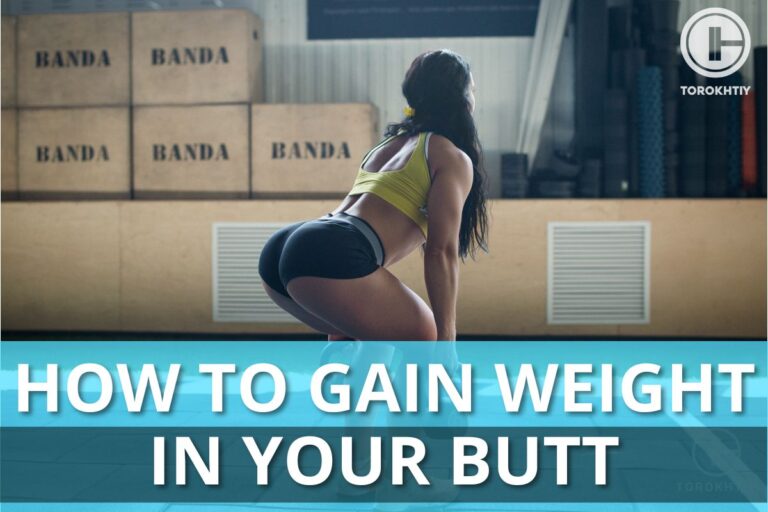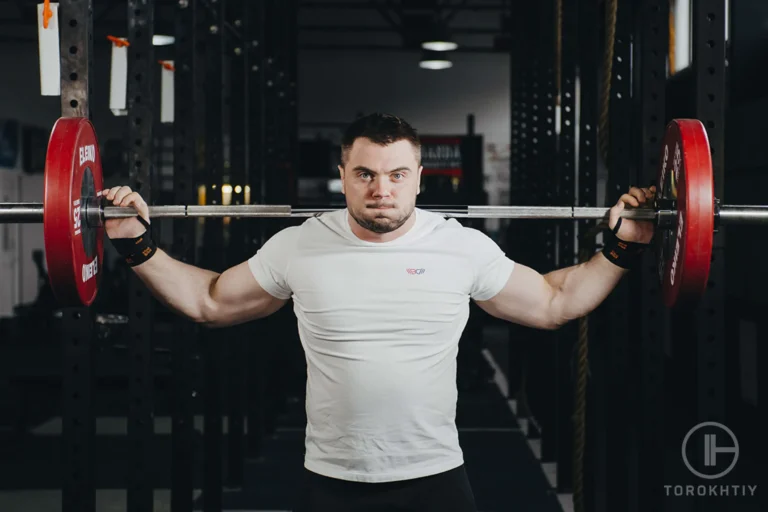Squatting Barefoot vs Shoes: What Makes a Better Squat?
Squatting is a highly beneficial exercise for the core muscles and the lower body making it a great addition to your training. But the question is: should you be squatting barefoot vs lifting shoes? In this article, we break down the key differences between the two.
Is it better to squat barefoot or not? If you have good lower body mobility or if you’re aspiring to increase your range, squatting barefoot can be more beneficial. However, if you have poor ankle mobility that limits the depth of your squat, you may be better off wearing weightlifting shoes.
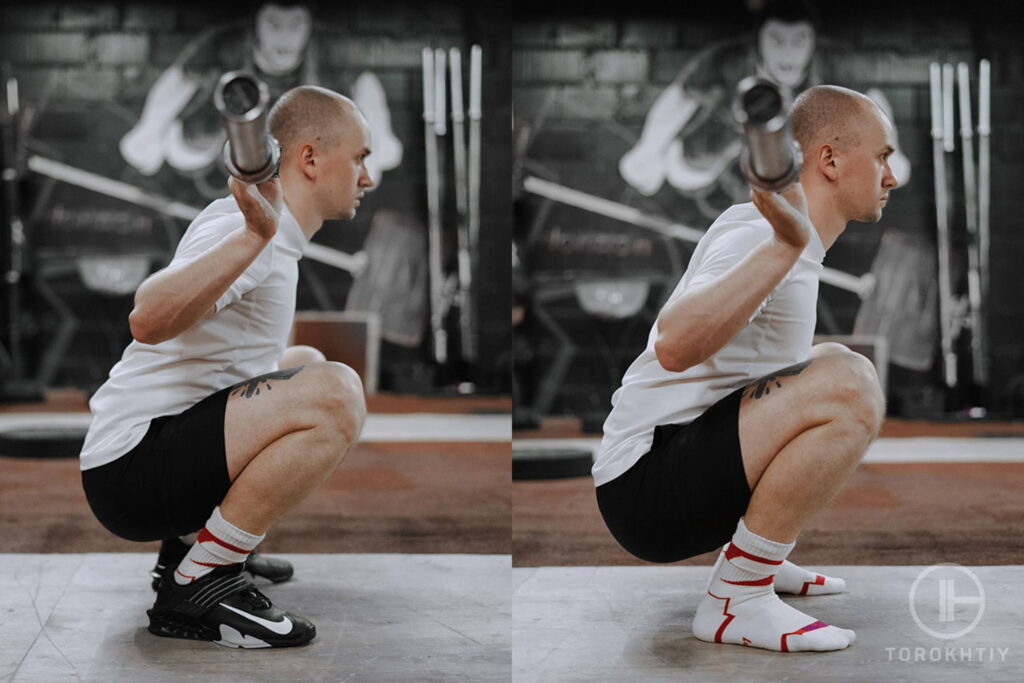
What Is Barefoot Squatting?
Barefoot squatting is, as the term implies, squatting without any shoes on. If you are to train barefoot, I recommend that you do so with socks on for hygiene purposes. The anatomy of the foot provides a better connection and a natural grip to the floor which makes a lot of people prefer squatting without shoes, among other things. And as they say, squatting with no shoes is always better than squatting with bad ones.
Benefits of barefoot squatting
Highlights mobility limitations. Squatting with shoes on can limit the potential of your ankle range of motion and overall mobility. Without shoes, your feet lack the extra support and elevation that assists your ankle to perform a squat without limitation. This highlights any range limitations so you can properly address them.
It’s crucial to have your feet flat on the ground when squatting, whether you’re wearing shoes or going barefoot. If you notice that your heel lifts off the floor at the bottom of a deep squat, chances are you have limited ankle range. You’ll find that simply squatting barefoot can enhance your ankle dorsiflexion. Ultimately, squatting shoeless can eventually help you squat deeper with better form even without any elevated shoes on.
Enhances technique and grip. It is vital to push through your heels when you squat and barefoot squatting makes pushing through the heels easier. Doing so effectively recruits the posterior chain which reduces the strain on the knees while strengthening your glutes, hamstring, and calves.
Additionally, When you are barefoot, your grip on the floor is improved dramatically. You provide your body with a wider and firmer foundation since squatting with no shoes allows your feet to spread out freely.
Adds power and builds strength. The foundation of your body are your feet and ankles, which have a considerably larger impact than you may imagine. Exercising without shoes gives your feet and ankles a chance to get stronger. Additionally, you are enhancing the strength of the tiny balance muscles in your lower limbs, which enhances your ability to lift heavier loads with more stability.
Wearing lifting shoes all the time may create an environment where your feet don’t have to work hard, robbing you of the progress you may achieve otherwise. Barefoot squats help your feet and ankles develop to their maximum potential, which in turn helps you make the most out of your squats.
Improves awareness and neuromuscular connection. The close contact with the ground that comes from being barefoot increases your level of awareness significantly. This enables you to accurately sense where your feet are pushing from, where you are carrying your weight, if you are balanced, whether one foot is pressing more than the other, or if something is off.
Your awareness is crucial to achieving the right form and getting the most out of each rep since the ability to identify what’s wrong allows you to adjust accordingly. All of this has to do with the feedback loop that carries messages from your muscles to your brain and back.
Another one of barefoot squats benefits is that when you are barefoot, your feet can communicate better with your brain, alerting you to adjust as needed. This connection can save you not only from a bad form but from potential injuries as well.
Enhances balance. You can balance more easily while you’re barefoot. Wearing shoes can numb your sensors, tricking your brain into thinking you are steady while in reality, you are only a squat away from suffering an injury.
When you’re barefoot, you can establish a greater connection to the ground underneath you, which improves your grip and your ability to spread your toes for further stability.
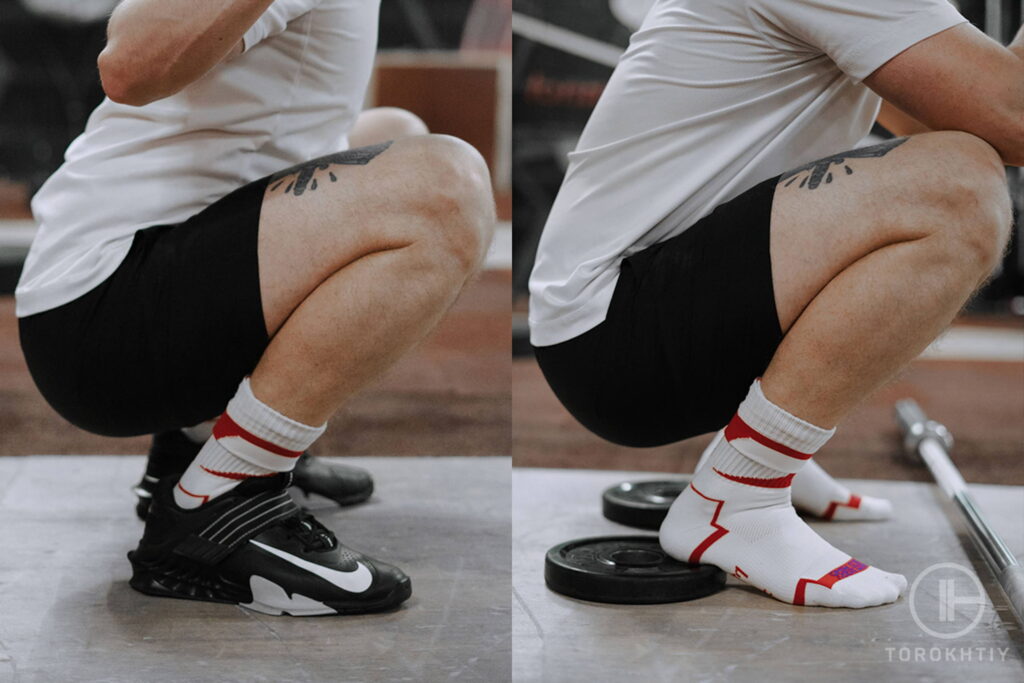
Drawbacks of Barefoot Squatting
Less support. If you have been squatting for a long time with shoes on, your feet and ankles may be weak with limited mobility. If this is the case, you will not have the same support you’re accustomed to if you squat barefoot. This may sometimes lead to some mishaps if you transition abruptly. The key here is to take it slow and easy if you want to start squatting shoeless after training with shoes on for quite some time.
May increase risk for low back pain. While being barefoot will increase your awareness of your foot position and the overall sensation of control, your technique will slightly alter.
In order to maintain stability, people frequently lean forward slightly with their chest, which induces stress on the lower back region since it increases the amount of shear force. This is especially true when there is a significant external load involved, such as in this case. Wearing lifting shoes is usually preferable if you’re already suffering from lower back pain.
Reduced anatomical feet protection. The smallest incident might result in major injury since you don’t have shoes to provide your feet with additional support. Additionally, your foot is not being protected in any way by anything. If you unintentionally drop the weightlifting equipment onto your feet, chances are high you might end up with broken bones.
May increase the risk of foot pain. If you have never squatted barefoot before, you can experience some discomfort or ache as a result of your feet no longer being able to slack off. This is typically for people who squat heavier loads. The extra pressure provided by the external load induces stress on the feet and this is magnified if the lift is done without shoes on. You should probably get some squat shoes if this does happen to you in order to avoid any foot pain.
Hygiene issues. Since hygiene is the most evident problem while doing squats without shoes, several gyms do not allow training barefoot. Consider how unsanitary feet can be and how much bacteria and fungi they spread. Walking around barefoot may predispose you to some podiatric issues.
But if you’re really into training shoeless, I recommend that you wear anti-slip socks on and clean your feet thoroughly after your workout session.
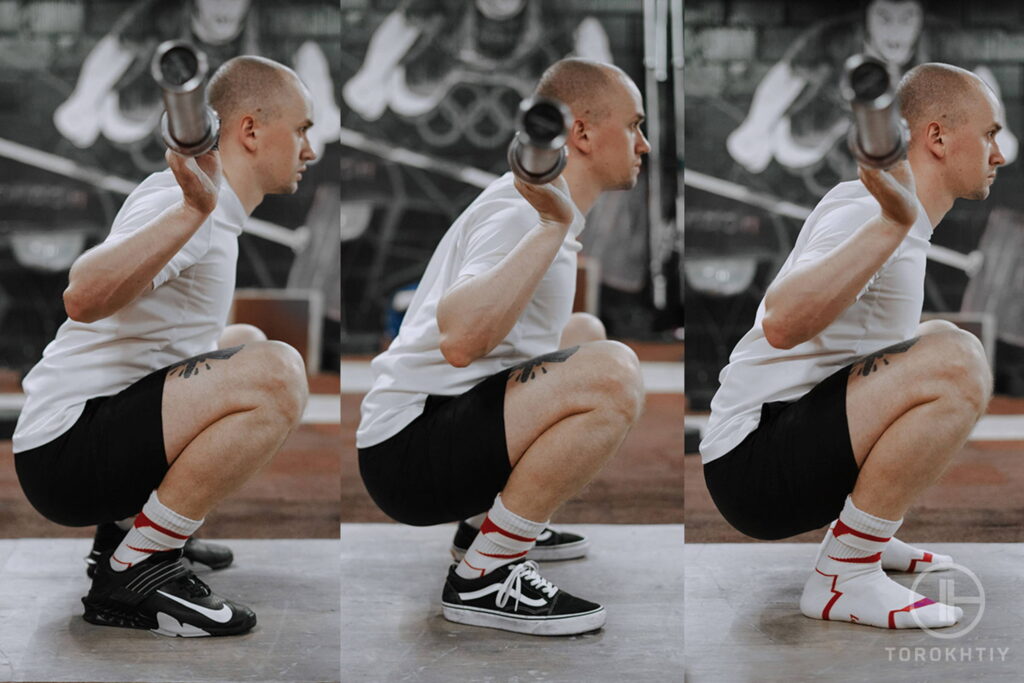
What Are Lifting Shoes Used For?
The whole debate surrounding squat shoes vs barefoot remains to be controversial. To help you decide between the two, here are some of the reasons why lifting shoes may be better than squatting barefoot.
Accommodates poor ankle mobility. Weightlifting shoes come with elevated heels to support you during lifting training. This is especially helpful for people with poor ankle mobility. People with limited ankle range of motion find it difficult to squat deeply while keeping the heel on the floor, reducing the stability of the movement.
Lifting shoes accommodate this limitation to allow you to descend lower and safer. This accommodation reduces the demand for ankle dorsiflexion so you can descend lower through increased knee flexion while promoting an upright trunk, essentially helping you get to a more proper form. So if you have a limited ankle range, opting to wear weightlifting shoes is highly beneficial for you. Heel elevations differ from one shoe to another so finding the right elevation for you is key to maximizing your squats.
Serves as a stable base. Weightlifting shoes give a stable base to catch your weight on. Typically, this is made of hard plastic, wood, or a mix of the two. An unsteady surface is the last thing you need in a lift. A solid foundation helps you feel safer throughout the lift and makes it easier for you to maintain the correct posture.
Lifting shoes may vary so it’s important to look for weightlifting shoes that offer a firm and solid base that does not allow your feet to be subjected to unnecessary movements that may throw you off balance.
Provides ankle support. For further ankle and foot support, most shoes are constructed of leather, rubber, or plastic coating. Even some shoes include an additional strap or two for further support. This stability combined with the strong foundation will give you a sense of security, which may make it easier for you to generate more power for your lifts.
To get the most support that you can get, make sure to find yourself a durable pair. Shoes that wear out easily tend to give you inferior support compared to those with a sturdy build.
Enhanced mobility. The elevated heel, stable foundation, and superior ankle support all lead to improved mobility during lifts, particularly in the ankles, knees, and hips. The odds of producing greater power and maintaining accurate postures grow as you become more mobile.
For the squat and Olympic lifts, insufficient ankle and hip flexibility is a limiting factor for maximum power output. So if you’re struggling with poor mobility, you might be better off wearing weightlifting shoes during your lifts.
Promotes safety. Injury prevention may be achieved using a weightlifting shoe. There is always a higher danger of injury when you are engaging in difficult movements and heavy lifting. You can lessen this risk by wearing shoes with a firm foundation and support. Shoes that are made of rubber with unstable bases and insufficient support may lead to poor biomechanics, and in turn, may lead to injury.
Additionally, lifting shoes may also act as an initial shield against injuries from weightlifting equipment. Although it will not completely save your feet from dropped weights, especially heavy ones, wearing one will still make your feet more protected compared to being completely barefoot.
Lifting Shoes We Recommend
UPDATE! Here’s a new model – Reebok Legacy Lifter III that can become a true discovery for those who are fans of the Legacy Lifter model, or their Lifters II are already out.

Despite the model has lots in common with the Legacy Lifter II, it has a novelty – the pump technology which can be useful for enlarging the volume of the tongue. This feature can benefit athletes with narrow feet by bringing better support and security, so the shoes hug the feet wholly.
In my whole career, I’ve tried countless weightlifting shoes in the market but my personal favorite is Reebok Men’s Legacy Lifter II Cross Trainer. The rigid massive heel cup and the solid base offer outstanding stability during my lifts and I feel that my ankles are better protected with these shoes on. I also find that its heel height offers just the right support I need and the traction the sole has on the floor keeps my feet firmly in place.
Overall, I like using these shoes because it helps me focus on my lifts more by making my feet one less thing to think about.
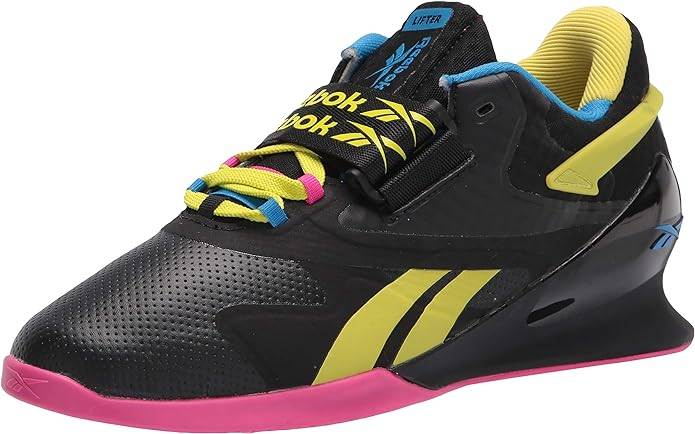
FAQs
Is it OK to deadlift barefoot?
By performing a deadlift without shoes, you may improve your balance, activate your posterior chain, and transmit force to the ground more effectively. This will enable you to lift heavier weight. However, a lot of gyms forbid deadlifting without shoes on. It’s also against the rules to compete barefoot in powerlifting competitions so you should wear lifting shoes if you plan to compete.
Should I squat in socks?
If you decide to squat barefoot, I highly recommend that you wear anti-slip socks. As mentioned above, the gym’s floor can be quite nasty so wearing socks should help you prevent any podiatric issues.
What type of shoes is best for squats?
For squats, it is best to opt for weightlifting shoes. The elevated heels, stable base, and ankle support all tie up to provide you with better form, higher power output, greater mobility, and safer lifts.
Conclusion
The question of whether should you squat barefoot or not is highly dependent on different factors. Generally, weightlifting shoes are beneficial for people with poor ankle mobility while squatting barefoot offers better grip and connection to the floor.
Feel free to share your thoughts or leave some questions in the comment section below.
Also read:
- Best Budget Weightlifting Shoes
- Best High Top Workout Shoes
- Are Vans Good for Lifting
- Raised Heels Squatting vs Flats
- Can You Deadlift in Squat Shoes
- Why Should You Wear Flat Shoes When Lifting
- Are Converse Good for Lifting
- Best Workout Shoes for Flat Feet
- Best Weightlifting Shoes For Wide Feet
- Lifting Slippers
- Best Lifting Shoes for Women
References:
- Comparison of Back Squat Kinematics between Barefoot and Shoe Conditions // International Journal of Sports Science & Coaching:
https://journals.sagepub.com/doi/abs/10.1260/1747-9541.8.3.571 - The loads on the lumbar spine during extreme weight lifting // NLM:
https://pubmed.ncbi.nlm.nih.gov/3589805/ - Investigation Into the Barbell Backsquat Comparing Weightlifting Shoes to Barefoot Conditions // Alex W. Pilkinton:
https://dc.etsu.edu/cgi/viewcontent.cgi?article=1338&context=honors - The Effect of Weightlifting Shoes on the Kinetics and Kinematics of the Back Squat // Journal of Sports Sciences: https://www.researchgate.net/publication/301550201_The_effect_of_weightlifting_shoes
_on_the_kinetics_and_kinematics_of_the_back_squat
Why Trust Us?
With over 20 years in Olympic Weightlifting, our team does its best to provide the audience with ultimate support and meet the needs and requirements of advanced athletes and professional lifters, as well as people who strive to open new opportunities and develop their physical capabilities with us.
By trusting the recommendations of our certified experts in coaching, nutrition, dietology, and sports training programming, as well as scientific consultants, and physiotherapists, we provide you with thorough, well-considered, and scientifically proven content. All the information given in the articles concerning workout programming, separate exercises, and athletic performance, in general, is based on verified data. We ensure that you can rely on our professionals’ pieces of advice and recommendations that can be treated as personalized ones which will benefit you and fully meet your needs.
The product testing process is described in more detail here
Author: Oleksiy Torokhtiy
Olympic Weightlifting Champion
Best Results: Snatch – 200 kg,
C&J – 240 kg
Oleksiy Torokhtiy is a professional athlete boasting 20 years of experience in Olympic weightlifting. With multiple European and World titles under his belt, he has showcased his prowess in two Olympic Games (Beijing 2008 and London 2012). Upon concluding his illustrious career, Oleksiy dedicated himself to coaching. By 2022, he had conducted over 200 weightlifting seminars worldwide. He is the visionary behind an international sportswear and accessories brand known for its motto, “Warm Body Cold Mind.” Additionally, he is an esteemed author and the creator of a series of training programs and eBooks.



